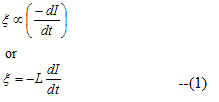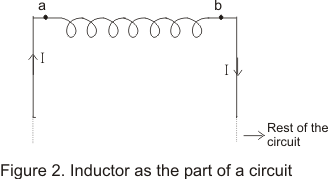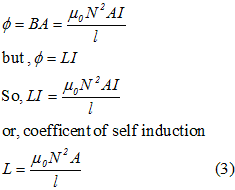Inductance
(1) Introduction
(2) Self Inductance
(3) Self induction of a long solenoid
(4) Energy in an inductor
(1) Introduction
- Before defining inductance first of all, we will define an inductor.
- Like capacitor, inductor is another component commonly in electronic circuits.
- An inductor consists of a coil wound on a core or former of a suitable material like solid or laminated iron. core or ferrites which are highly ferromagnetic substances.
- when a current through an inductor changes am emf is induced in it which opposes this change of current in the inductor.
- This property of inductor or coil due to which it opposes change of current through it called the inductance denoted by letter L.
- Unit of inductance is henry(H).
(2) Self Inductance
- Consider the figure given below

- When we establish a current through an inductor or coil, it generates a magnetic field and this result in a magnetic flux passing through the coil as shown in figure 1(a).
- If we vary the amount of current flowing in the coil with time, the magnetic flux associated with the coil also changes and an emf ξ is induced in the coil.
- According to the Lenz’s law, the direction of induced emf is such that it opposes its cause i.e. it opposes the change in current or magnetic flux.
- This phenomenon of production of opposing induced emf in inductor or coil itself due to time varying current in the coil is known as self induction.
- If I is the amount of current flowing in the coil at any instant then emf induced in the coil is directly proportional to the change in current i.e.

where L is a constant known as coefficient of self induction. - If (-dI/dt)=1 then ξ=L
Hence the coefficient of self induction of a inductor or coil is numerically equal to the emf induced in the coil when rate of change of current in the coil is unity. - Now from the faraday's and Lenz’s laws induced emf is

comparing equation 1 and 2 we have,
or Φ=LI - Again for I=1, Φ=L
hence the coefficient of self induction of coil is also numerically equal to the magnetic flux linked with the inductor carrying a current of one ampere - If the coil has N number of turn’s then total flux through the coil is
Φtot=NΦ
where Φ is the flux through single turn of the coil .So we have,
Φtot=LI
or L=NΦ/I
for a coil of N turns - In the figure given below consider the inductor to be the part of a circuit and current flowing in the inductor from left to right

- Now when a inductor is used in a circuit, we can use Kirchhoff’s loop rule and this emf(Self induced emf) can be treated as if it is a potential drop with point A at higher potential and B at lower potential when current flows from a to b as shown in the figure
- We thus have
Vab=LdI/dt
(3) Self induction of a long solenoid
- Consider a long solenoid of length l, area of cross-section A and having N closely wound turns.
- If I is the amount of current flowing through the solenoid them magnetic field B inside the solenoid is given by,

- Magnetic flux through each turn of the solenoid is,

(4) Energy in an inductor
- Changing current in an inductor gives rise to self induced emf which opposes changes in the current flowing through the inductor.
- This self inductance thus plays the role the inertia and it is electromagnetic analogue of mass in mechanics.
- So a certain amount of work is required to be done against this self induced emf for establishing the current in the circuit.
- In order to do so, the source supplying current in a circuit must maintain Potential difference between its terminals which is done by supplying energy to the inductor.
- Power supplied to the inductor is given by relation
P=ξI ---(4)
where
L is Self inductance and
dI/dt is rate of change of current I in the circuit. - Energy dW supplied in time dt would be
dW=Pdt
=LI(dI/dt) dt
=LIdI
and total energy supplied while current I increases from o to a final value I is
- Once the current reaches its final value and becomes steady ,the power input becomes zero.
- The energy so far supplied to the inductor is stored in it as a form of potential energy as long as current is maintained.
- When current in circuit becomes zero, the energy is returned to the circuit which supplies it.

No comments:
Post a Comment